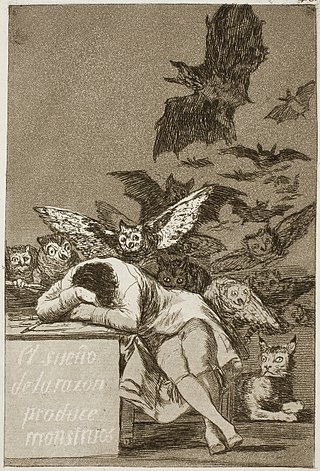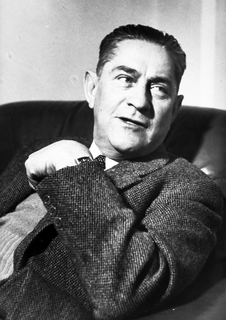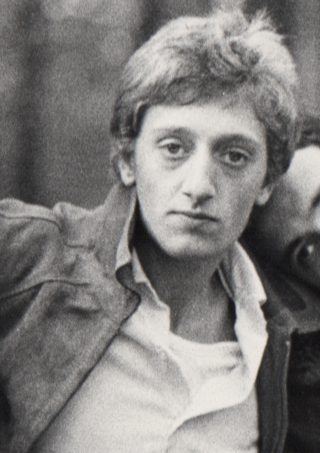
Francisco José de Goya y Lucientes was a Spanish romantic painter and printmaker. He is considered the most important Spanish artist of the late 18th and early 19th centuries. His paintings, drawings, and engravings reflected contemporary historical upheavals and influenced important 19th- and 20th-century painters. Goya is often referred to as the last of the Old Masters and the first of the moderns.

Los Prisioneros was a Chilean rock band formed in San Miguel, Santiago, in 1982. Considered one of the most important Latin-American bands of all time, they've been evaluated as pioneers of Rock en español by Latin American media and musicians, and as the band with the strongest socio-political impact in Chile. The group would develop a new wave sound that would have its roots in British punk rock, in particular The Clash, and would incorporate rockabilly, reggae and ska influences, and later on synthpop, and would make themselves known for their controversial, witty and subversive lyricism that criticized the socio-economic structures, education and societal attitudes of dictatorship-era Chile and Latin America as a whole. This would cause their music to be banned by the Chilean mainstream media between 1985 and 1990, but their music would continue to spread there, aided by word of mouth and shared homemade cassette tapes.

Los caprichos is a set of 80 prints in aquatint and etching created by the Spanish artist Francisco Goya in 1797–1798, and published as an album in 1799. The prints were an artistic experiment: a medium for Goya's condemnation of the universal follies and foolishness in the Spanish society in which he lived. The criticisms are far-ranging and acidic; the images expose the predominance of superstition, the ignorance and inabilities of the various members of the ruling class, pedagogical short-comings, marital mistakes and the decline of rationality. Some of the prints have anticlerical themes. Goya described the series as depicting "the innumerable foibles and follies to be found in any civilized society, and from the common prejudices and deceitful practices which custom, ignorance or self-interest have made usual".

The Disasters of War is a series of 82 prints created between 1810 and 1820 by the Spanish painter and printmaker Francisco Goya (1746–1828). Although Goya did not make known his intention when creating the plates, art historians view them as a visual protest against the violence of the 1808 Dos de Mayo Uprising, the subsequent cruel war that ended in Spanish victory in the Peninsular War of 1808–1814 and the setbacks to the liberal cause following the restoration of the Bourbon monarchy in 1814. During the conflicts between Napoleon's French Empire and Spain, Goya retained his position as first court painter to the Spanish crown and continued to produce portraits of the Spanish and French rulers. Although deeply affected by the war, he kept private his thoughts on the art he produced in response to the conflict and its aftermath.

The Sleep of Reason Produces Monsters or The Dream of Reason Produces Monsters is an aquatint by the Spanish painter and printmaker Francisco Goya. Created between 1797 and 1799 for the Diario de Madrid, it is the 43rd of the 80 aquatints making up the satirical Los caprichos.

The Colossus, is known in Spanish as El Coloso and also El Gigante, El Pánico and La Tormenta. It is a painting traditionally attributed to Francisco de Goya that shows a giant in the centre of the canvas walking towards the left hand side of the picture. Mountains obscure his legs up to his thighs and clouds surround his body; the giant appears to be adopting an aggressive posture as he is holding one of his fists up at shoulder height. A dark valley containing a crowd of people and herds of cattle fleeing in all directions occupies the lower third of the painting.
Luis Ciges Martínez was a Spanish film actor. He appeared in 140 films between 1958 and 2002. His father was Manuel Ciges.

Fernando de Fuentes Carrau was a Mexican film director, considered a pioneer in the film industry worldwide. He is perhaps best known for directing the films El prisionero trece, El compadre Mendoza, and Vámonos con Pancho Villa, all part of his Revolution Trilogy on the Mexican Revolution.

The Puerto Rico Department of Correction and Rehabilitation is the law enforcement executive department of the government responsible for structuring, developing, and coordinating the public policies in Puerto Rico, an unincorporated territory of the U.S. The department has authority over its correctional system and the rehabilitation of its adult and young population who have broken the law.

The Inquisition Tribunal, also known as The Court of the Inquisition or The Inquisition Scene, is a 46-by-73-centimetre oil-on-panel painting produced by the Spanish artist Francisco Goya between 1812 and 1819. The painting belongs to a series which also includes Bullfight, The Madhouse and A Procession of Flagellants, all reflecting customs which liberals objected to and wished were abandoned, but their reform was opposed by the absolutist (autocratic) policy of Ferdinand VII of Spain.

Ángel Omar Vivas Perdomo is a Venezuelan Brigadier General. He has made himself known as an outspoken opponent of the politicization of the Venezuelan Armed Forces, by going to the supreme court to challenge the introduction of a war cry originally created by Fidel Castro, as the motto for the military in Venezuela. He was arrested, prosecuted, and on 1 March 2012, sentenced to 4 months and 15 days in jail for having challenged the motto in court. On 7 April 2017, he was arrested again during a SEBIN operation that tricked him into helping a young man that hit his car into the front door of his house, three years after a detention order was published during the 2014 Venezuelan protests.

The Apodaca prison riot occurred on 19 February 2012 at a prison in Apodaca, Nuevo León, Mexico. Mexico City officials stated that at least 44 people were killed, with another twelve injured. The Blog del Narco, a blog that documents events and people of the Mexican Drug War anonymously, reported that the actual (unofficial) death toll may be more than 70 people. The fight was between Los Zetas and the Gulf Cartel, two drug cartels that operate in northeastern Mexico. The governor of Nuevo León, Rodrigo Medina, mentioned on 20 February 2012 that 30 inmates escaped from the prison during the riot. Four days later, however, the new figures of the fugitives went down to 29. On 16 March 2012, the Attorney General's Office of Nuevo León confirmed that 37 prisoners had actually escaped on the day of the massacre. One of the fugitives, Óscar Manuel Bernal alias La Araña, is considered by the Mexican authorities to be "extremely dangerous," and is believed to be the leader of Los Zetas in the municipality of Monterrey. Some other fugitives were also leaders in the organization.

Óscar Jaenada Gajo is a Spanish actor. He portrayed Camarón de la Isla in Camarón: When Flamenco Became Legend (2005) and Cantinflas in Cantinflas (2014).

Jordi Sànchez i Picanyol is a Spanish political activist from Catalonia, who was president of the Catalan National Assembly (ANC) between May 2015 and November 2017.

A group of inmates were involved in a prison riot on 24 May 2019 in the police station cellblocks in Acarigua, Portuguesa state, Venezuela. The riot allegedly began when inmate Wilfredo Ramos was killed following ten days of protests against the denial of visits by relatives.

Genoveva Forest Tarrat was a Spanish far-left activist, writer and prisoner. Born into an anarchist family in Barcelona, she studied medicine in Madrid. During the 1970s, she supported the Basque terrorist group ETA in their resistance to the government of dictator Francisco Franco. From 1974 to 1977, she was imprisoned for complicity in the Cafetería Rolando bombing (1974), which killed 13 people in Madrid. After Spain's transition to democracy, she served a term as a senator from 1992 until 1993. The wife of the Spanish writer Alfonso Sastre, she died in May 2007.

Rogelio Enrique San Francisco Cobo, better known as Quique San Francisco, was a Spanish actor and comedian. He was a noted figure in the so-called cine quinqui scene.
The Directory of National Security was the secret police of Venezuela from 1938 until is disestablishment in 1958.
Elidio Espinoza was a Peruvian politician and colonel, who served on the force of the National Police of Peru.

Jorge Alejandro Muyshondt Álvarez was a Salvadoran politician who served as a national security advisor to Salvadoran President Nayib Bukele from 2019 to 2023. Muyshondt previously served as Bukele's security advisor from 2017 to 2019 while Bukele was mayor of San Salvador.
























